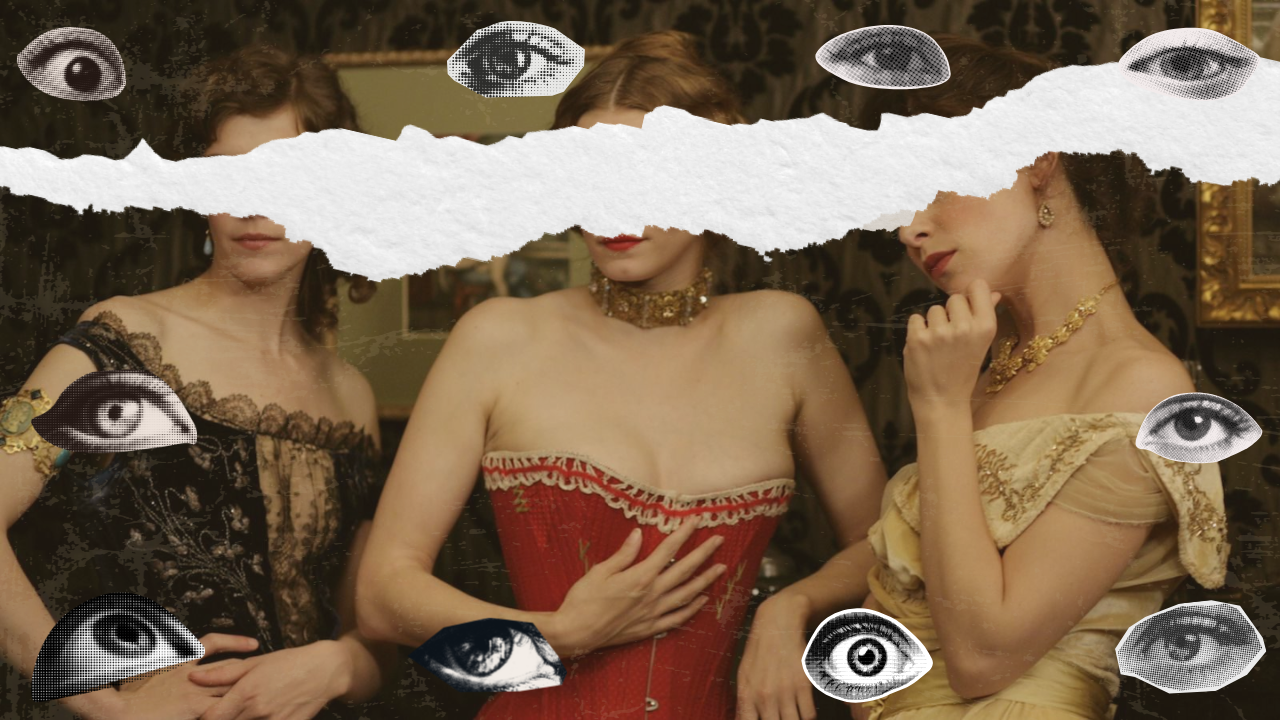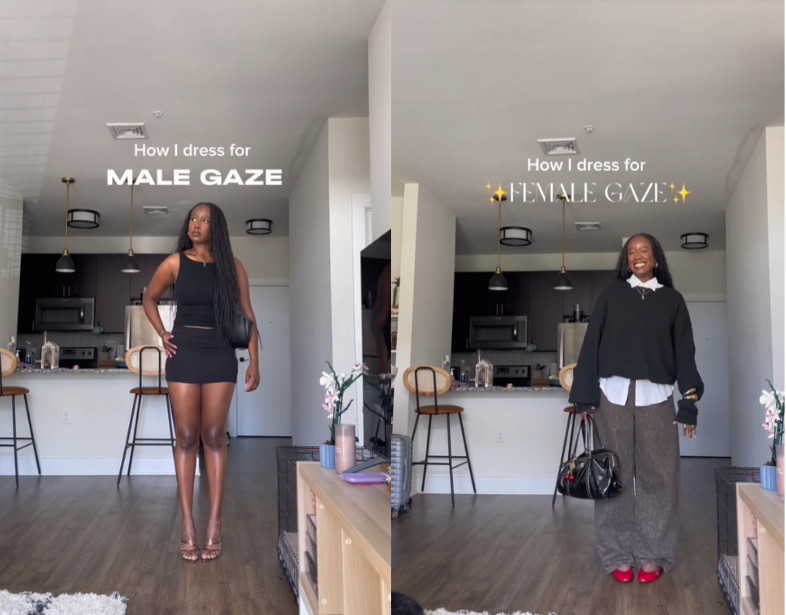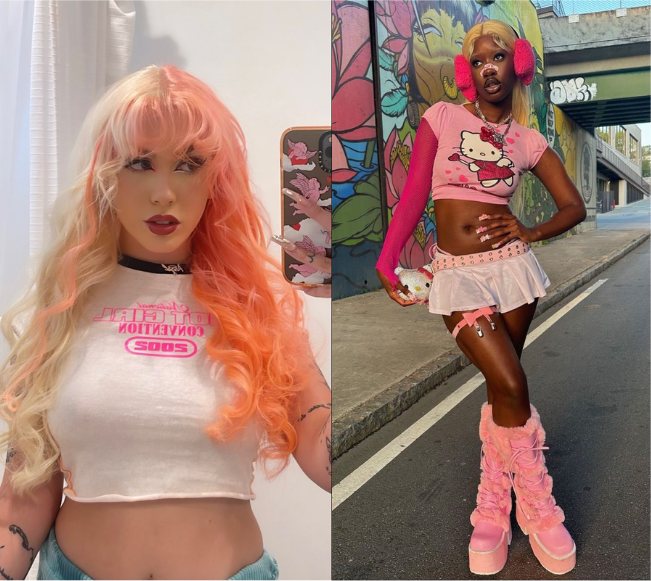
Dressing for the Male Gaze vs the Female Gaze: How a feminist theory took the internet by storm

Chances are if you’re on TikTok on the internet in general you must’ve at least once come across people trying different outfits with the words “male gaze” vs “female gaze”. What are those terms and what do they mean? The term “female gaze” originated as a counterpoint to the “male gaze,” a concept introduced by film theorist Laura Mulvey in the 1970s. The male gaze refers to the way films and literature depict women from a masculine, heterosexual lens, presenting them as plot devices and objects for the male audience. The female gaze, on the other hand, seeks to portray female characters as subjects with agency and depth, focusing on their lived experiences and perspectives rather than objects of desire.
TLDR; It’s a theory used to analyse the treatment of female characters within different forms of media and literature. Now that the explanations are out of the way, what does any of this have to do with clothes? Well with the surge in popularity of TikTok and its various aesthetic trends such as 'dark academiacore' and 'cottagecore', the concept of the female gaze has gained attention. Since 2021, this term has been circulating on TikTok, thanks to female/female-presenting creators who showcase their style transformations over the years. TikTok user Madison Wild (@madisonxwild) explains the female gaze within the context of fashion, where the idea refers to fashion choices that are traditionally appealing to men, such as revealing clothing, bodycon dresses, or styles that emphasise one physique in ways that align with conventional male desires. In contrast, the "female gaze" in fashion is often associated with clothing that prioritises comfort, individuality, and self-expression over stereotypical attractiveness to men. This might include oversized clothing, eclectic styles, or looks that are seen as more authentic or "for women, by women." While this concept isn't entirely new, it has gained a new label due to the evolving nature of language. However, rigidly categorising personal styles under the male or female gaze ultimately makes the concept meaningless and a little reductive.

The platform isn’t known for its nuance but rather for its viral and new trends with catchy terms. Identity and curating an aesthetic have become a fundamental aspect of our online presence. What we are, what we do, and how we look are all part of it. This isn’t a new phenomenon by any means, cliques in high school settings have existed for a long time, and there are a ton of films and TV shows about it.
So is the female “male gaze” vs “female gaze” in fashion a real thing? Not really. Fashion items don’t cater to specific "gazes." Yes, the culture surrounding fashion is often tricky e.g. fashion in itself can be political and there’s to say that the recent trend of the "female gaze" concept online has encouraged experimentation in fashion and personal style. However, the notion of dressing for a specific gaze oversimplifies the reality that fashion choices are influenced by various factors. People dress for many reasons—cultural heritage, comfort, personality, social and economic status or simply because an outfit feels right that day. It's not about dressing for men, women, or any specific group; it's about what makes the individual feel their best, so okay yes for argument's sake if attracting a partner is a part of it, it doesn’t mean that’s all it is. Implying that one’s fashion choices are primarily about appealing to or rejecting the preferences of the opposite sex undermines an individual’s autonomy, ironically projecting and reinforcing harmful stereotypes under the guise of being progressive. This has led to it becoming a subtle form of slut-shaming on the internet and perpetuating the very misogynistic views it tries to destroy.
Now not all the content can be seen as misogynistic, after all at its core it’s just a basic trend that people are hopping on to but what becomes of the trend after it goes beyond just a fun hashtag? Take TikTok’s hyper-femininity movement, where women embrace ultra-feminine styles of the Y2K era as a form of empowerment and push the expectation that feminine means weakness and superficiality. This raises the question of whether such trends can also reinforce traditional gender norms. The irony is that within the broader “male gaze” vs "female gaze" trend, hyper-femininity is often looked down upon in favour of more traditionally masculine styles for the latter. It seems almost trivial, yet telling, that feminine styles are often undervalued even in movements meant to challenge stereotypes.

One of the most important aspects is to remember that fashion doesn’t exist within the binary of gendered appeal. Many styles are appreciated universally, and what one person finds attractive or meaningful in fashion can differ widely from another. Limiting fashion to a framework of male vs. female gaze often fails to acknowledge the diversity of taste, expression, and identity that fashion embodies.
Ultimately, while the trend of categorising fashion under the male or female gaze might seem like harmless fun or just another viral TikTok moment, it may just offer a starting point for conversations about gender and aesthetics and the importance of moving beyond these misused terms. Fashion is not confined to the binary of gendered appeal; it is a dynamic form of self-expression that reflects the diversity of human experience. By embracing this diversity, we can appreciate fashion for what it truly is—a reflection of individuality, creativity, and the ever-evolving nature of identity.
So, the next time you're tempted to squeeze yourself into a hashtag or frame your style through someone else’s gaze, just remember you're not a trend or a character and no viral aesthetic can ever define your true self.
To purchase a copy of the first issue, follow this link: The Grey, Issue 1: Fashion & Gender
and follow on Instagram @thegreyzine for more.
Post a comment